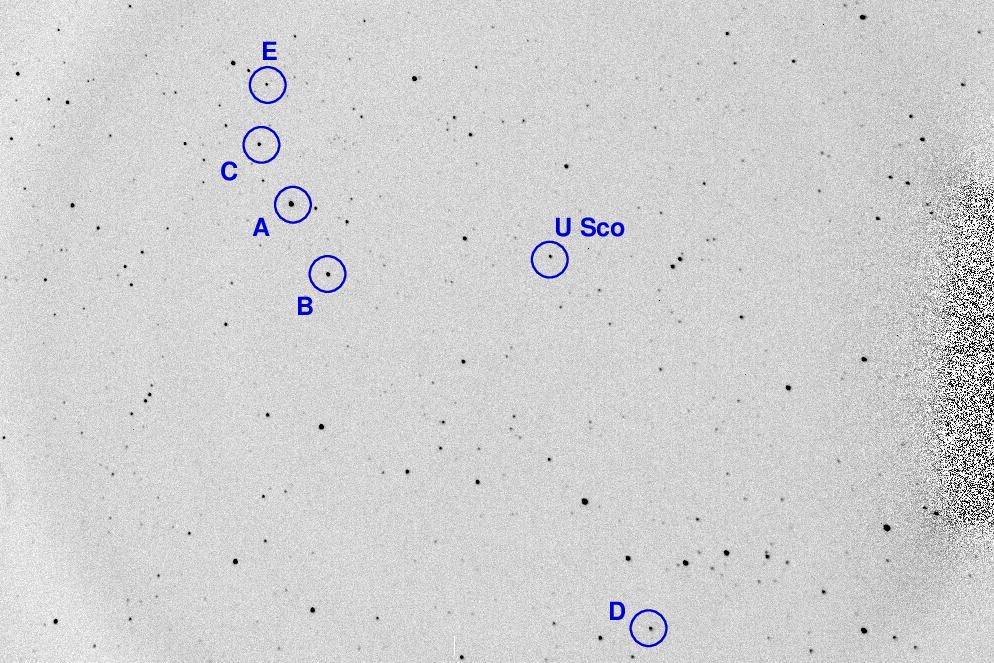
On the night of Jun 30/Jul 01, 2022, under mediocre conditions, I acquired images of the outbursting cataclysmic variable star U Sco.
Tonight's observations were ruined, mostly, by clouds which came and went. They weren't thick enough to cause me to give up, but the resulting photometry had large uncertainties. Sigh.
In the rolloff structure, there was good news and bad news.
After finishing with U Sco, I took a few pictures of Comet C/2017 K2, just for fun. Look at the end of this page for the image.
U Sco is a cataclysmic variable which only rarely is caught in an outburst. This one was first noticed at UT 2022 June 6.720 by Masayuki Moriyama. The star reached a peak brightness of about V = 8, but faded quite a bit by this evening; it is currently about V = 14.9.
The main setup was:
Notes from the night:
The object is located at
RA = 16:22:30.78 Dec = -17:52:42.8 (J2000)
A chart of the field is shown below. The size of the chart is about 42 x 30 arcminutes.

I've marked the location of several comparison stars as well, which appear on the AAVSO chart of comparison stars.
I'll use star "A" to shift my instrumental magnitudes to the V-band scale.
I took a photo of the finder TV's screen when pointing to this target; this could be a useful reference for the future:

The sky value shows clouds early and late.

The FWHM graph below shows a rise near the end, due to airmass.

Using aperture photometry with a radius of 7 pixels in clear filter (binned 4x4, each pixel is 1.052 arcsec, so a radius of 7.4 arcsec), I measured the instrumental magnitudes of a number of reference stars and the target. Following the procedures outlined by Kent Honeycutt's article on inhomogeneous ensemble photometry, I used all stars available in each image to define a reference frame, and measured each star against this frame.
Sigma-vs-mag plots show that the floor was about 0.019 mag, which is pretty bad :-(

The change in zeropoint shows large gaps -- I removed images from those intervals, where clouds were particularly thick.

The measurements show a small dip, but are too noisy to say much more.

You can download my measurements below. A copy of the header of the file is shown to explain the format.
# Measurements of U_Sco made at RIT Obs, UT 2022 Jul 1, # in mediocre conditions, # by Michael Richmond, # using Meade 12-inch LX200 and ASI 6200MM. # Exposures 45 seconds long, clear filter. # Tabulated times are midexposure (FITS header time - half exposure length) # and accurate only to +/- 1 second (??). # 'mag' is a differential magnitude based on ensemble photometry # using a circular aperture of radius 7 pix = 7.4 arcseconds. # which has been shifted so AAVSO 000-BBX-431 has mag=10.707 # which is its V-band magnitude according to AAVSO. # # UT_day JD HJD mag uncert Jul01.08814 2459761.58814 2459761.59310 14.648 0.051 Jul01.08875 2459761.58875 2459761.59371 14.614 0.037 Jul01.08940 2459761.58940 2459761.59436 14.575 0.046
I spent several hours working on the cables running around the 14-inch telescope. I removed all of them, and discarded several which were no longer being used. I then re-strung those which are active, bundling several together to prevent tangling. I moved the mount over a wide range of motions to verify that the cables had enough slack; it looks okay, thought there isn't as much extra room as I'd like.
I verified that the computer can talk to the Astro-Physics 1200 GTO mount. I can use the ASCOM driver, or MaximDL, or Stellarium, to control the mount. Good!
Unfortunately, during tests in the evening, the Dec motor suddenly started whirring loudly when I tried making a small move. It ran away and would not stop, even when I pressed the STOP button on the keypad. I was forced to turn the power off to the mount to stop it. After several trials, I found that any request for Dec motion would lead to the same wild response. The trouble, I'm almost certain, is the Dec portion of the Y-cable. It had been damaged long ago, and when I examined it closely, I found several places where the casing had been worn off, exposing the bare wires inside. Rats.
I'll order a new Y-cable.
I took a series of 20 images of the comet, with no filter and a 45-second exposure time. The object was reasonably high in the sky, and the clouds weren't very bad. I combined the best seven exposures to create the median image shown below. North is up, East to the left, and the exposure is centered around UT 2022 Jul 01 05:53 = JD 2459761.745. You can see a faint tail extending to the North.

Last modified 7/01/2022 by MWR.